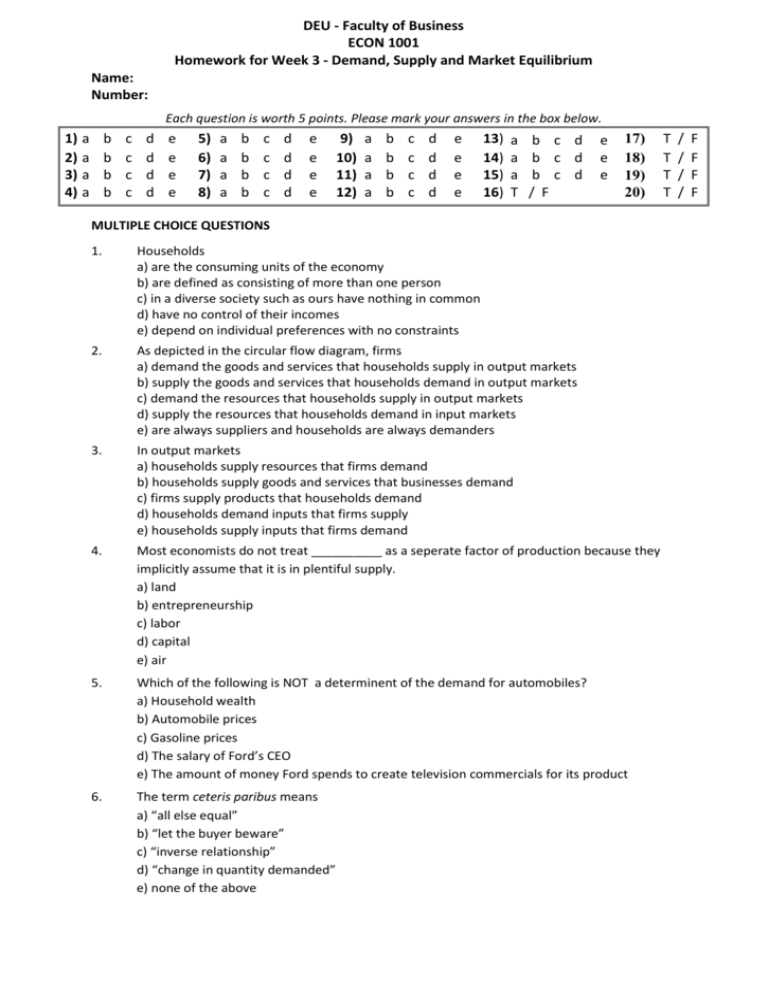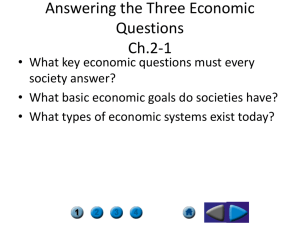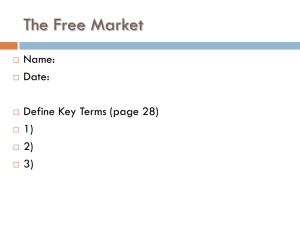Homework for Ch. 3
advertisement

DEU - Faculty of Business ECON 1001 Homework for Week 3 - Demand, Supply and Market Equilibrium Name: Number: Each question is worth 5 points. Please mark your answers in the box below. 1) a 2) a 3) a 4) a b b b b c c c c d d d d e e e e 5) 6) 7) 8) a a a a b b b b c c c c d d d d e e e e 9) 10) 11) 12) a a a a b b b b c c c c d d d d e e e e 13) 14) 15) 16) a a a T b c d b c d b c d / F e e e 17) 18) 19) 20) MULTIPLE CHOICE QUESTIONS 1. Households a) are the consuming units of the economy b) are defined as consisting of more than one person c) in a diverse society such as ours have nothing in common d) have no control of their incomes e) depend on individual preferences with no constraints 2. As depicted in the circular flow diagram, firms a) demand the goods and services that households supply in output markets b) supply the goods and services that households demand in output markets c) demand the resources that households supply in output markets d) supply the resources that households demand in input markets e) are always suppliers and households are always demanders 3. In output markets a) households supply resources that firms demand b) households supply goods and services that businesses demand c) firms supply products that households demand d) households demand inputs that firms supply e) households supply inputs that firms demand 4. Most economists do not treat __________ as a seperate factor of production because they implicitly assume that it is in plentiful supply. a) land b) entrepreneurship c) labor d) capital e) air 5. Which of the following is NOT a determinent of the demand for automobiles? a) Household wealth b) Automobile prices c) Gasoline prices d) The salary of Ford’s CEO e) The amount of money Ford spends to create television commercials for its product 6. The term ceteris paribus means a) “all else equal” b) “let the buyer beware” c) “inverse relationship” d) “change in quantity demanded” e) none of the above T T T T / / / / F F F F 7. The law of diminishing marginal utility a) was discovered by Alfred Marshall b) helps to explain why demand curves are very likely to slope downward c) explains why consumers are better off when prices of goods decrease d) is caused by the law of “ceteris paribus” e) none of the above 8. An increase in the equilibrium price could be caused by a) a decrease in supply or a decrease in demand b) an increase in supply or an increase in demand c) a decrease in supply or an increase in demand d) an increase in supply or a decrease in demand e) none of the above; once in equilibrium the price will not change 9. Ticket scalpers sell tickets for events such as the World Cup or the Super Bowl for prices many times greater than the printed price on the ticket. This is an example of a a) market in equilibrium b) surplus causing an increase in the market price c) shortage causing an increase in the market price d) market in which the quantity demanded is less than the quantity supplied e) none of the above 10. When government regulators allowed the price of cable television to increase, the demand for television satellite dishes increased. From this information, we can conclude that cable television and television satellite dishes are a) substitutes b) complements c) normal goods d) inferior goods e) luxuries 11. During the 1990’s, the price of subcompact cars decreased and fewer were sold. From this information, we could conclude that a) the demand for subcompact cars increased b) the costs of manufacturing subcompact cars had decreased c) the price of large cars must have also decreased d) the demand for subcompact cars had decreased e) sumcompact cars are an inferior good 12. Suppose the bicycle industry spends millions of dollars on a “Ride your bike to work” campaign, and the campaign is successful in persuading many people about the joys of biking. As a result, which of the following would occur? a) an increase in the price of bicycles b) an increase in the quantity of bicycles sold c) a decrease in the price of gasoline d) all of the above e) a and b only 13. Suppose that drought kills half of the nation’s corn crop. As a result, the equilibrium price of corn would ___________, and the equilibrium quantity of corn would ____________ . a) increase, increase b) increase, decrease c) decrease, increase d) decrease, decrease e) decreasei not change 14. The Law of Demand refers to the a) negative relationship between price and quantity demanded b) positive relationship between price and quantity demanded c) negative relationship between income and quantity demanded d) positive relationship between expectations and quantity demanded e) none of the above 15. In factor markets a) households demand resources that firms supply b) households supply goods and services that businesses demand c) firms supply products that households demand d) households demand inputs that firms supply e) households supply inputs that firms demand TRUE/FALSE QUESTIONS 16. Input and output markets are connected through the behavior of both firms and households. 17. A single person living alone is not considered a household. 18. When supply and demand curves shift in the same direction, the equilibrium price and quantity do not change. 19. Households supply the funds that firms use to buy capital goods. 20. When excess demand occurs in an unregulated market, there is a tendancy for price to fall.








